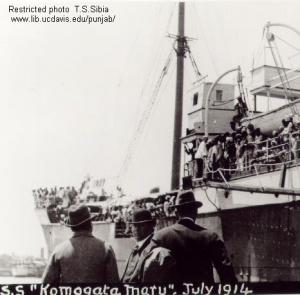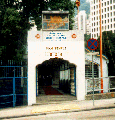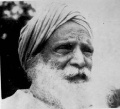Komagata Maru

The Kamagata Maru was a Japanese steam liner, that was chartered by an affluent businessman, Gurdit Singh, to bring Indian immigrants to Canada. It began its journey from Hong Kong, sailed to Shanghai, China, then to Yokohama, Japan, and then to Vancouver, British Columbia, Canada. This journey took place in 1914, carrying 376 passengers from Punjab, India.
During the period before 1920's the whole of North America has a policy of discrimination against coloured races which was thinly disguised to appear a something else. The dominate white governments of USA and Canada were determined not to allow the flow of 'brown' or 'black' people to the continent. In the year 1900 the census reported 2050 people from India on the North American continent.
The majority of these people were Punjabis who had settled in Canada. They had come with the hope of finding work so that they could improve their economic situation from what it had been in the Punjab. Upon arrival in Canada they encountered numerous hardships and discrimination. The white Canadians people wanted the "brown invasion" to stop. They felt that the growing number of Indians would take over their jobs in factories, mills and lumber yards. It was these insecurities which led British Columbia to pass stringent laws discouraging the immigration of Indians to Canada.
Indians had to have at least $200 on their person to enter British Columbia and had to have come via direct passage from India, which in those days was practically impossible. These were very unreasonable laws as the average Indian only earned about ten cents a day. The Canadian government was also pressuring steamship companies to stop selling tickets to Indians.
In 1907 a bill was passed denying all Indians the right to vote. They were prohibited to run for public office, serve on juries, and were not permitted to become accountants, lawyers or pharmacists. All this was done to stop the "brown Invasion." On the other hand Japanese and Chinese were immigrating in unlimited numbers.
So when the the ship Kamagata Maru docked at Vancouver, the passengers were not allowed to land in Canada. Eventually, the ship was forced to return to India. The passengers consisting of 340 Sikhs, 24 Muslims, and 12 Hindus, who were all were British subjects had to suffer the hardship of many weeks sailing back. This was one of the most notorious "incidents" in the history of early 20th century exclusion laws in Canada and the United States designed to keep out immigrants of Asian origin.
Gurdit Singh, from Sarhali, Amritsar, was a well-to-do businessman in Singapore who was aware of the problems that Punjabis were having in getting to Canada due to exclusion laws. He initially wanted to circumvent these laws by hiring a boat to sail from Calcutta to Vancouver. His aim was to help his compatriots whose journeys to Canada had been blocked.
Immigration controls in Canada
During the first two decades of the 20th century, Canada had recently passed several bills limiting the civil rights of Indians, including the right to vote, to hold public office, to serve on juries, or practice as pharmacists, lawyers, and accountants. However, because India, like Canada, was part of the British Empire, Canadian authorities did not pass exclusion laws explicitly targeting those of Indian origin. The Imperial authorities in London had noted Indian resentment when the White Australia policy was put in place in 1905; this policy was in turn adopted by New Zealand.
When Canada started making provisions to block immigration from India, it was warned by London to be cautious in its approach, and to be aware that its actions might inflame nationalist fervour in India. With this in mind, Canadian immigration authorities devised an ingenious plan to indirectly halt Indian immigration to the country. To be admitted to Canada, immigrants had to come by "continuous journey" from their country of birth and enter with at least $200 cash on their persons. The continuous journey regulation did not mention race or nationality and on the surface seemed fair and applicable to all immigrants. It was, however, an open secret that the regulation was to apply only to people from British India. Canadian Pacific did run a very lucrative shipping line between Vancouver and Calcutta. However, the Canadian government forced the company to stop this service. It was now impossible to come via continuous journey to Canada.
This was one of many hidden measures that Canada undertook to enforce a hidden "White Canada" policy. To put these measures in context, restrictions on Asian immigration were being enacted at a time when Canada was accepting massive numbers of European immigrants (over 400,000 in 1913 alone - a figure that remains unsurpassed to this day).
In chartering the Komagata Maru, Gurdit Singh's goal was to challenge the continuous journey regulation and open the door for immigration from British India to Canada.
The voyage
Hong Kong became the point of departure. The ship was scheduled to leave in March, but Singh was arrested for selling tickets for an illegal voyage. He was later released on bail and given permission by the Governor of Hong Kong to set sail, and the ship left Hong Kong on April 4 with 165 passengers. More passengers joined at Shanghai (April 8), and the ship arrived at Yokohama on April 14. It departed from Yokohama on May 3 with its complement of 376 passengers, and arrived in Burrard Inlet, near Vancouver, on May 23. "This ship belongs to the whole of India, this is a symbol of the honour of India and if this was detained, there would be mutiny in the armies" a passenger told a British officer. The Indian Nationalist revolutionaries Bhagwan Singh, Barkatullah and Balwant Singh joined the ship en route. Balwant Singh was head priest of the Gurdwara in Vancouver and had been one of three delegates sent to London and India to represent the case of Indians in Canada. Ghadarite literature was disseminated on board and political meetings took place on board.

Arrival in Vancouver
When the Komagata Maru arrived in Canadian waters, it was not allowed to dock. The Conservative Premier of British Columbia, Richard McBride, gave a categorical statement that the passengers would not be allowed to disembark.
Meanwhile a "Shore Committee" had been formed with Hussain Rahim and Sohan Lal Pathak involved. Protest meetings were held in Canada and the USA. At one, held in Dominion Hall, Vancouver, it was resolved that if the passengers were not allowed off, Indo-Canadians should follow them back to India to start a rebellion (or Ghadar). The shore Committee raised $22,000 dollars as an installment on chartering the ship. They also launched a test case legal battle in the name of Munshi Singh, one of the passengers. On July 7, the full bench of the Supreme Court gave a unanimous judgement that under new Orders-In-Council, it had no authority to interfere with the decisions of the Department of Immigration and Colonization. The Japanese Captain was relieved of duty by the angry passengers, but the Canadian government ordered the harbour tug, Sea Lion to push the ship out on its homeward journey. On July 19, the angry passengers mounted an attack. Next day the Vancouver newspaper The Sun reported: "Howling masses of Hindus showered policemen with lumps of coal and bricks... it was like standing underneath a coal chute".
The government also mobilised the HMCS Rainbow, a former Royal Navy ship standing idle in Esquimalt. Under the command of Commander Hose, with troops from the Irish Fusiliers, 72nd Highlanders, and the 6th DCOR regiments. In the end, only 24 passengers were admitted to Canada, since the ship had violated the exclusion laws, the passengers did not have the required funds, and they had not sailed directly from India, another requirement to make entry more difficult. The ship was turned around and forced to sail back to Asia, departing on July 23.
Return to India
The Komagata Maru arrived in Calcutta, India on September 26. Upon entry into the harbour, the ship was forced to stop by a British gunboat, and the passengers were placed under guard. The ship was then diverted approximately 17 miles to Budge Budge, where the British intended to put them on a train bound for Punjab. The passengers wanted to stay in Calcutta, and marched on the city, but were forced to return to Budge Budge and reboard the ship. The passengers protested, some refusing to reboard, and the police opened fire, killing 20 and wounding nine others. This incident became known as the Budge Budge Riot.
Gurdit Singh managed to escape and lived in hiding till 1922. He was urged by Gandhi to give himself up as a true patriot. He was imprisoned for five years.
Memorials and depictions
In 1951, the government of the new Republic of India erected its first monument at Budge Budge to commemorate the massacre there.
A plaque commemorating the 75th anniversary of the departure of the Komagata Maru was placed in the Sikh gurdwara (temple) in Vancouver on July 23, 1989.
A plaque commemorating the 80th anniversary of the arrival of the Komagata Maru was placed in the Vancouver harbour in 1994.
In 2004, Ali Kazimi's feature documentary Continuous Journey was released, This is the first in-depth film to examine the events surrounding the turning away of the Komagata Maru. The primary source research done for the film led to the remarkable discovery of rare film footage of the ship in Vancouver harbour. Eight years in the making Continuous Journey has won over ten awards, including the Most Innovative Canadian Documentary at DOXA, Vancouver 2005, and most recently, Golden Conch at the Mumbai International Film Festival, 2006
Additional Kamagata Maru Photographs
References
- Johnston, Hugh J.M., The Voyage of the Komagata Maru: the Sikh Challenge to Canada's Colour Bar. Delhi: Oxford University Press. 1979.
- Kazimi Ali, Continuous Journey, feature-length documentary about the Komagata Maru. 2004
- Kesar Singh, Canadian Sikhs (Part One) and Komagata Massacre. Surrey, B.C.: 1989.
- Ward, W. Peter, "The Komagata Maru Incident" in White Canada Forever: Popular Attitudes and Public Policy toward Orientals in British Columbia. Montreal: McGill-Queen's University Press, 2d ed., 1990, pp. 79-93.
- Robie L. Reid, "The Inside Story of the Komagata Maru" in British Columbia Historical Quarterly, Vol V, No. 1, January 1941, p. 4
- Sailani Desh Bhagat by Harnam Singh Tundilaat, a well-known "Ghadarite" (ghost written by Lal Singh Kamla Akali)
- The Punjabi heroic Tradition by Dr. Satya M. Rai, Professor, Department of Political Science, Hindu College, Delhi Uni.
- Ghadar Movement by Harish K. Puri, professor, Political Science, Guru Nanak Dev University This book is published by Guru Nanak Dev University.
- "Babbar Akali Movement, A Historical Survey," Dr. Gurcharan Singh, Aman Publications, 1993.




